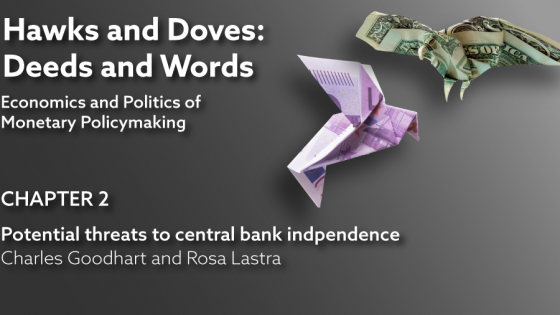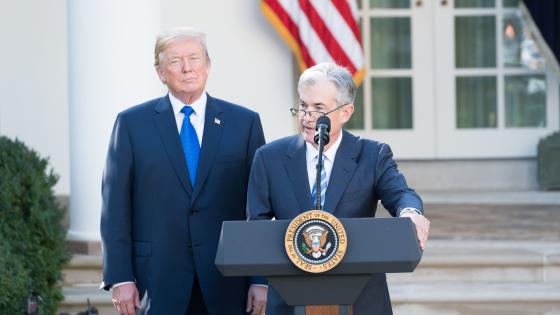Editor's note: This column first appeared as a chapter in the VoxEU eBook "Hawks and Doves: Deeds and Words - Economics and Politics of Monetary Policymaking", available to download here.
Some 30 years ago, New Zealand introduced an arrangement combining operational independence and inflation targetry for the central bank. Although this regime change was introduced as one aspect of the reforms of the then Minister of Finance, Roger Douglas, to the governance of public sector institutions and industries as a whole, it rapidly caught on in the next few years as best practice for central banks around the world. There were several reasons for this. First, it helped to bring to an end the long- running and inconclusive debate between monetarists and Keynesians. Both could regard the new regime as an extension and improvement on their previous positions. The monetarists could see an inflation target as representing a monetary target after adjustment for the unforeseeable and unforecastable variations in velocity, which had complicated and confused the application of (pragmatic) monetary targets in the previous decade. On the other hand, neo-Keynesians could apply an inflation target in terms of a direct link between official interest rates and output and prices, along the lines later described by Woodford (2003).
There were also a number of additional important conditions which provided support to the adoption of this new regime. The first, and most important, was the general acceptance of the concept of the medium- and long-run vertical Phillips curve. In earlier decades, when most economists had believed in a downwards-sloping Phillips curve at all horizons, the choice of where to position oneself along this curve – with a trade-off between higher employment and lower inflation (right wing), or lower unemployment and higher inflation (left wing) – was patently a key political issue, as was evidenced in many countries in the 1950s and 1960s. The concept of the vertical Phillips curve allowed central bankers to declare with conviction that the adoption of a low inflation target had absolutely no longer term deleterious effect on growth, but actually reinforced it by removing the inevitable distortions within the economy that significant inflation introduced. This was crucial to the delegation of price stability to an independent central bank.
The new regime also, however, benefited from an additional new concept, that of time inconsistency. The idea that politicians would pledge to maintain price stability, but would seek, often covertly, to raise demand and real output above the natural equilibrium rate as elections neared was very attractive to economists, commentators and market analysts, despite having (in the UK at least) rather weak empirical support. What was more generally observable, however, was that markets were fearful that left-wing governments would choose to be more expansionary, deficit-prone and ‘irresponsible’ than right-wing governments. Accordingly, there was a generalised tendency for left-leaning governments to introduce central bank independence and operational independence in order to protect their flank against financial market disturbances. Besides New Zealand, the same syndrome could be observed in the UK, where CBI was introduced by Gordon Brown after having been rejected by both Thatcher and Major, and also in South Africa, where central bank independence was initiated by the ANC.
Besides this theoretical support, there were some empirical macroeconomic developments providing extra support for central bank independence. Around this time, public-sector debt ratios (i.e. debt/GDP) in many developed countries reached their minimum post-WWII levels. This meant that debt management, naturally a Treasury function, and monetary control could be separated much more easily than in earlier decades, when the two arms of policy were intimately connected. It also meant that occasions when the central bank would seek to raise interest rates, in order to constrain inflation, would be less worrying to ministers of finance concerned with controlling the overall size of the deficit and the burden on taxpayers.
Nonetheless, the independence of central banks was always limited by politics, the ability of government to redesign such arrangements (except the ECB), and politicians’ control of top appointments.
Growing strains
This new regime was remarkably successful for much of its first two decades. These were the NICE years (non-inflationary continuous expansion) and the Great Moderation, during which central bank governors achieved remarkable status. But in recent years there have been increasing strains, notably after the onset of the Global Crisis. As a start, the empirical basis for continuing belief in the long-run vertical Phillips curve has weakened. Over the last two decades or so, levels of unemployment (the pressure of demand) have varied widely, but inflation has remained fairly stable at around 2%. The actual, empirical Phillips curve has become closer to horizontal than to vertical. While this is no doubt largely due to the success of central banks in maintaining their inflation targets, and public expectations thereof, it does raise questions about the fundamental understanding of inflation (Tarullo 2017) and their ability to control it, and also questions about whether the inflationary consequences of seeking to run the economy at a higher pressure of demand, for a time at any rate, would necessarily be so bad. Indeed, Janet Yellen of the Board of Governors of the Fed raised just such an issue in a speech in 2016. What may lie ahead is a clash between central banks – concerned for their price stability mandate as unemployment falls below the assessed, natural rate – and populist politicians committed to achieving faster growth.
Moreover, central banks, alongside most others, failed to foresee or head off the Global Crisis and their focus on a narrowly construed price stability-oriented monetary policy made them ignore or insufficiently calibrate the perils of financial instability, as discussed below. Although their immediate response in 2008/9 was exemplary, and did succeed in preventing another Great Depression, their record afterwards, from 2010 to 2016, was consistently one of failing to forecast the sluggishness of growth of either output or inflation, casting some doubt on their competence, economic understanding and capacities.
That said, central banks have at least sought to maintain an expansionary approach, at a time when fiscal policy has been reined back, for a variety of reasons, good or bad, while other (supply-side) policies have failed to make much of an appearance. So, given that central banks have often appeared to be ‘the only game in town’ (El-Erian 2016), one might have expected more praise combined with more criticism of the fiscal authorities. But that has not generally been the case.
Some of the brickbats flung at central banks have related to the slow tempo of the recovery; others to the possibility that one aspect of the unconventional measures – namely, negative nominal interest rates – may have had a counter-productive effect, for example by weakening commercial bank profitability. Perhaps the main general criticism is that the unprecedented low levels of nominal and real interest rates have been stimulating over-borrowing, a debt over-hang, which may encourage present expenditures but at the expense of future fragility and potential crises (i.e. borrowing from the future). But the main reasons for such attacks have related to distributional and directional effects.
Distributional effects have always happened as a result of changes in interest rates (for example, between creditors and debtors). But quantitative easing (QE) and unconventional monetary policies are now seen in the context of the winners and losers from globalisation. One reason may be that the trends in nominal and real interest rates over the last three decades have been so large and persistent. Earlier, it was probably believed that there would be swings and roundabouts but that inflation, and both nominal and real interest rates, would fluctuate around a norm, so temporary benefits to one side, or the other, would in the longer run wash out. This has not happened over the last three decades. While central banks claim, with justification, that the effects of their expansionary policies have not worsened, and may have improved, income inequality, their detractors have responded by claiming that such policies will have worsened wealth inequality, particularly between that section of the young whose parents can help them onto the housing ladder, and the remaining section who can get no such help.
Directional effects relate to QE and asset purchases having an impact on some particular sectors of the economy, such as the housing market, via purchases of mortgage-related securities. But the argument that central banks should only purchase (safe) government debt is historically naïve. Until the 1930s, under the real bills doctrine, the argument was reversed; until then it was the short-term bills of exchange of trade and industry that should be the preferred instrument, not government debt. Oddly enough, if directional effects are held to be within the political province, there was no widespread suggestion that the central bank should decide on the quantum of base money to be injected into the economy and then pass it on to an intermediary, staffed and controlled by the politicians and the ministry of finance, who would then decide on whom the recipients should be.
There is, furthermore, yet another ‘D’ effect, duration, which has so far not figured much in discussion of central bank policies, but where we expect the discussion to become sharper. QE has drastically been reducing the duration of the consolidated public-sector debt, including the central bank within the public sector, just at a time when debt management precepts would have suggested that a country would have been well advised to lengthen the duration of its public-sector debt to take advantage of extraordinarily low interest rates. As interest rates start rising, and the central bank has to start paying out great wads of money to the banks holding massively expanded balances with themselves, this latter criticism may become much more vocal.
Of the three Ds – distribution, direction and duration – we expect concerns about the first two to slacken as policy becomes re-normalised, but objections to the third to grow. Imagine the populist outcry as rising nominal rates not only slow growth and employment and raise mortgage costs, but also seem primarily to benefit the cash-flow of banks via interest paid on massively expanded reserves at the central bank!
Moreover, debt ratios have been rising quite rapidly in almost all developed economies (except Germany) in the last few decades, but this has not led to higher debt service ratios because interest rates have been steadily declining over this same period. So, there has been no cause for conflict between the central bank, in pursuit of price stability, and the ministers of finance, concerned with deficits and tax burdens. But as re-normalisation takes place and interest rates rise, this continuing harmony is likely to fray. In addition, demographic changes bringing about worsening dependency ratios, and even in some countries a reduction in the available workforce, will reduce growth and the tax base, just at a time when the ageing of populations may cause a continuing increase in public-sector expenditures. Such underlying developments will tend to be inflationary, forcing central banks to raise interest rates, and putting them in greater conflict with politicians and Treasuries. Our expectation is that the politicians will win. Central bank independence was nice while it lasted, but it owed a great deal to the supporting conditions that enabled it to achieve such great success in its early years. RIP.
Financial stability conditions
There is a further aspect to current concerns about central bank independence . This is that the Global Crisis has led all concerned – central banks, politicians, economists and commentators – to apply a further second objective to central banks, namely, financial stability. This has complicated the life of central banks in several respects. First, a single objective with a single instrument (interest rates) was much easier to manage, and to communicate, than a system with multiple objectives, which might at times require trade-offs. Second, inflation was relatively easily measureable (though the complications of measuring inflation have tended to be overlooked), and the use of such metrics allowed the central bank to be accountable and transparent. In contrast, financial stability is not – at any rate, not as yet – measureable, which makes it much more difficult for the central bank to be accountable and transparent in its pursuit of this objective. Furthermore, it is a goal that transcends geographic boundaries and institutional mandates. Third, some instruments whereby financial stability may be achieved, such as macroprudential measures, are largely untried, at least in large developed economies, and some of these instruments (for example, loan-to-value ratios and debt service ratios) can impact directly on non-financial actors, and could be described as outside the ambit of an independent central bank. Fourth, there is a concern in some quarters that delegating micro- and macroprudential to the central bank, in addition to their monetary policy operational independence, makes the power and influence of a non-elected technocratic body too great to be acceptable within a democratic society. In some cases, for example in Sweden, such measures are placed within a separate financial stability authority (the Finansinspektionen). But, if so, there remains an unhappy split between the ultimate responsibility that a central bank must bear for financial stability and the information, institutions and operating instruments which can be used to bear on the achievement of this objective.
Unlike the clarity of the regime introduced in New Zealand some 30 years ago, the newly widened regime, with multiple objectives and multiple instruments, is not clearly defined and perhaps even legally uncertain, and with expanded mandates there are concerns about adequate accountability and legitimacy.1
At a conference in 2017 to mark the 20th anniversary of the granting of central bank independence to the Bank of England, both of its initial political founders, Gordon Brown and Ed Balls, argued that in the realm of financial stability, decisions on policies should involve some political oversight, perhaps with the introduction of an oversight committee along the lines of the Financial Stability Oversight Committee (FSOC) in the US, which would be chaired by a minister but would include the central bank and any other financial supervisory institutions in the field.
Perhaps an alternative would be for the central bank to limit its macroprudential policies to those solely affecting the banking system, such as the counter-cyclical buffer ratio and limits on banking finance to housing and other risky fields. There are some signs that the Financial Policy Committee in the UK has this distinction in mind, since it applied its additional control on mortgage lending to banks alone, rather than to mortgages provided from any financial institution, whether bank, or non-bank. While limiting the focus of central bank macroprudential policies to banks alone might bolster their claims to independence, it does have the danger of running foul of border problems, whereby regulated financial flows move to unregulated non-banks, thereby making the overall riskiness of the whole system potentially worse rather than better. Again, we have warned about this problem in an earlier paper.2
While it is possible – but, as argued earlier, uncertain – that monetary policy may continue to be independently operated, at the same time as there is greater interaction between politicians and Treasuries, on the one hand, and central banks, on the other, in the field of financial stability, there is a possibility that the blurring of independence in the field of financial stability may also raise questions for central banks’ independence more broadly.
We will see.
Authors’ note: This column draws in part on Goodhart and Lastra (2017).
References
El-Erian, M A (2016), The only game in town, Random House.
Dabrowski, M, R Lastra, C Goodhart, A Ubide, E Gerba and C Macchiarelli (2015), “The Interaction between Monetary Policy and Banking Regulation”, report prepared at the request of the European Parliament ahead of the Monetary Dialogue with President Draghi, September.
Goodhart, C and R Lastra (2010), “Border Problems”, Journal of International Economic Law 13(3): 705-718.
Goodhart, C and R Lastra (2017), “Populism and Central Bank Independence”, Open Economies Review.
Tarullo, D (2017), “Monetary policy without a working theory of inflation”, Hutchins Center Working Paper No. 33, Brookings.
Woodford, M (2003), Interest & Prices, Princeton University Press.
Endnotes
[1]For further discussion of several of these latter issues, see the second half of Goodhart and Lastra (2017).
[2] Goodhart and Lastra (2010); see also Dabrowski et al. (2015).



